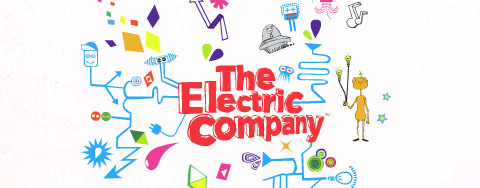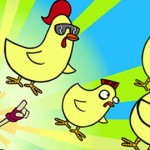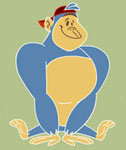

The Electric Company (2009)

Hey You Guys!
Following will be some shameless PBS promotion, but I say that more as a fan than as a corporate cog. By now, you have probably heard that a new version of The Electric Company has premiered on PBS Kids. It’s not a remake of the show we grew up with back in the 1970s, it’s really more of a re-imagining of the show. I loved the show back when it premiered the first time. The show back then was targeted to eight-year-olds, and I had just turned eight when it premiered. As we all remember, it featured actors our parents knew, like Rita Moreno and Bill Cosby, and actors we’d all know someday, like Morgan Freeman. But what I liked about The Electric Company the most was that it was cool and it was funny, certainly to my eight-year-old sensibilities. But most importantly, it had animation in it. What I didn’t know at the time was that between Electric Company and Sesame Street, I was getting to see work from some of the most important independent animators of the time. When I finally started attending animation festivals in the early 1980s, there was a reason why some of the films looked familiar to me — I had been trained by the Children’s Television Workshop for years.
I have never been a huge fan of working on remakes. I dodged a number of Looney Tunes remakes from various WB-related concerns while I was at Cartoon Network. I guess someone was making them, but somehow I managed to escape without the taint of a “SpaceJam Babies” on my resume. And yet when talk of a new Electric Company came up back when I had first started at PBS, I was excited. The person heading it all up, Karen Fowler, was a Sesame Workshop producer, but she and I had met briefly in the short period we had overlapped when we were both at Nickelodeon, and I knew her to be very funny and very cool. I figured it would be an adventure.
In 2005, PBS, the Corporation for Public Broadcasting, and our various production partners — WGBH, Sesame Workshop and Out of the Blue Enterprises — were the recipients of a grant from the Department of Education and that allowed us to have enough funding to make Super Why, Martha Speaks and The Electric Company.
The Electric Company premiered January 23 and if you have had the chance to check it out, you may have noticed that Sesame Workshop is still putting independent animators to work teaching kids reading skills. The show is one part Monkees, one part Fame, one part Batman, and one part independent animation festival.
In some ways, the show is vaguely reminiscent of the old show, with sketches, animation and songs. Most of each episode is a live action narrative. A group of four friends, known as the Electric Company, each have a particular magical ability to produce, control, manipulate and play with words and letters. And then there are the neighborhood pranksters, their nemeses, if you will. Each of the pranksters has some magical ability was well, but of course they use it for evil, and then mayhem ensues. I may be a little biased, but I am pretty sure that Francine Carruthers is one of the funniest bad guys on TV ever.
Each narrative story is broken into four parts and in between these four sections is where you will find the animation.
The animation on The Electric Company actually starts with the title, which was created by the graphic design studio Plus et Plus.
And then we get to the animated shorts. In the first season, eight different studios worked on these interstitials. For a look at some episodes from the series and a look at some of these shorts, you can check out pbskidsgo.org/electriccompany.
 If you are wondering who did what, here is a list.
If you are wondering who did what, here is a list.
Screen Novelties did the Jack Bowser shorts, which are parodies of “24,” where Jack Bowser must read a sentence in 24 seconds. Clambake Animation did the “Captain Cluck and the Poultry Patrol” shorts. Clambake is run by Carl Adams, who once worked at Soup2Nuts and produced Home Movies. Independent animator Pat Smith of Blend Films did the “Pet Store” and “Josephine” shorts. Stefan Bucher of 344 Design did the pixillated “Daily Letters” spots, which feature monsters that are turned into letters as an artist colors the space around them. The “Laughing Orangutans” shorts were done by Joanna Davidovich. Blacklist, a division of the animation studio Psyop did the Music Man spots. Six Point Harness did the “Odd Couple” spots. And LA-based artist Selena Kassab did the “Rally Racer” spots.
The two things you might catch in the new show that you might recognize are the silhouette blends, of course, and Paul the Gorilla, who makes an occasional appearance. And they do yell, “Hey You Guys!” This part is very important, as you know. Without this line, it’s not actually The Electric Company.
 There are also a few things that are new to this incarnation of the series. Shock, the beatboxer, will help to remind you that we are no longer in the groovy early 1970s, but that we are actually nearing the second decade of a new millenium. But Shock’s turntable blending letters to make words will show you exactly how the concept of blending words works in this new era. There are also some songs and shorts performed by musicians you will recognize, such as Wyclef, Ne-Yo, and Common. My favorite segment is one that we run in meetings — a Ramones-esque Jimmy Fallon singing “Pocket Full of H’s.” You can check this one out on the PBS website, too.
There are also a few things that are new to this incarnation of the series. Shock, the beatboxer, will help to remind you that we are no longer in the groovy early 1970s, but that we are actually nearing the second decade of a new millenium. But Shock’s turntable blending letters to make words will show you exactly how the concept of blending words works in this new era. There are also some songs and shorts performed by musicians you will recognize, such as Wyclef, Ne-Yo, and Common. My favorite segment is one that we run in meetings — a Ramones-esque Jimmy Fallon singing “Pocket Full of H’s.” You can check this one out on the PBS website, too.
The series runs on Fridays on most PBS stations and on weekends (you know, check your local listings…) It is good to know that no matter what we do to the art of animation, we can somehow still teach reading with it.

.png)